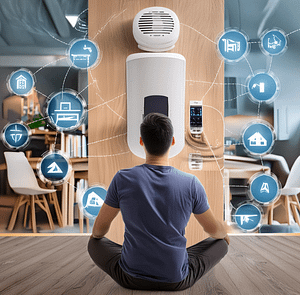Table of Contents

In the midst of the chaos of digital media, why is mindfulness important?
People frequently overlook the value of relaxation and mental clarity because they are so engrossed in technology and digital media. Mindfulness in the digital age, the general human population frequently disregards the value of mindfulness, which compromises their everyday sanity. In the absence of rest, conditions like stress, anxiety, and hypertension—all of which are highly prevalent among the populace—develop. Uncontrollably scrolling through social media to make up for sleep deprivation results in serious psychological disorders that have a significant influence on people’s lifestyles.
Being mindful means staying grounded in the here and now and not obsessing over uncontrollably occurring events. Mindfulness is a practice that requires consistent dedication. It is a method that helps to eradicate the illnesses brought on by our technologically driven society and enhance focus and health.
Importance of finding balance in a constantly connected world
One way to conceptualize mindfulness is as the process of strengthening your conscious mind to the point where it is able to form strong connections with its environment. Being occupied is one of the most significant disadvantages of digital media. We tend to skip taking care of our physical and mental health amidst the constant hustle of this world.
In the simplest terms, it is very important to take care of our health. We are human beings, made of flesh and blood, who have constant chemical processes occurring in the body. The strongest evidence of our existence is the hormones our bodies are releasing, which allow us to experience emotions. Practicing mindfulness gives us the strength to pay attention to what our body needs. It helps us make sense of things and makes it possible for us to notice things that we otherwise do not pay attention to. It is important to practice mindfulness, as it teaches us to find joy in the little things.
Impact of Digital overload
In order to understand the impact, it is important to highlight the definition of digital overload.
“Digital overload” is the feeling that comes from using technology excessively. We might experience fatigue from this, which could have a number of long-term negative effects on our health.
There are several triggers of ‘digital overload’ that lead to its occurrence. It includes
- the illusion of multitasking, which gives us the impression that we can handle multiple tasks at once. Only when tasks are completed one at a time can they be completed well.
- Our constant sense of connectedness causes us to overwork and strain our lifestyles.
- The internet’s limitless supply of information may cause people to consume too much of it.
These are a few of the many points that make a person experience digital overload, which would further be the reason for several health conditions like:
- Feeling worn out
- Being exhausted
- Feeling fatigued
- Inability to focus
- Lack of productivity
- Absence of enthusiasm for activities
- Physical symptoms can include cramping in the muscles, headaches, shoulder pain, and reddening and itching of the eyes.
Effects of continuous digital stimulation on psychological well-being
We already know the advantages that social media and technology bring to us. As is common knowledge, however, “everything has its own pros and cons,” and in the case of digital device use, those drawbacks are typically outweighed by their benefits. Constant use of social media invades our me-time, and we enjoy it so much that we permit it to do so. Therefore, we compromise on taking care of our mental and physical health. The effects are so contagious that they also start to be the cause of detrimental changes in our behaviors. We pay less attention to the real world as we become more and more absorbed in the digital one, and by the time we are expected to pay attention to it, we have already expended most of our energy in the superficial realm. We can become fatigued as a result, and this has a negative impact on our behavior, which frequently manifests as yelling at our family or becoming irritated over little things. Our capacity for patience and focus on a single task wanes.
Understanding Mindfulness
Mindfulness can be defined in the simplest terms by saying that it is our ability to be attentive to our surrounding environment. We can feel present even in the midst of the nonstop chaos of the digital world when we put our devices down and concentrate only on our breathing. Whenever we lose our way, mindfulness enables us to reclaim our lives. We feel grounded and reassured by it. Everyone possesses the ability to be mindful; daily practice is all that is needed.
As a lot of us have started to earn a living from home, which demands hours of sitting in the same place in front of laptop screens, it is essential to include some physical movements in our routine. Our bodies need to move, or else it would be detrimental to our health. Stretching periodically during the workday can improve blood flow and oxygenate all parts of our bodies. Yoga is another type of mindfulness that supports both physical and mental well-being.
The benefits of this practice include reduced stress, improved performance, and increased focus. Including mindfulness in your everyday routine can help you be more productive and motivated to work. Given our heavy reliance on digital media, it may be challenging to form the habit at first, but it will become more manageable once we begin to see benefits.
Strategies for Cultivating Mindfulness
There are several strategies to nurture mindfulness. Yoga and exercise are two of the most known ways in which most people in today’s world have adapted to keep themselves fit. A few of them are:
- meditation: This is one of the most important ways to implement mindfulness. It helps to ground us. This also helps to connect with reality.
- Journaling: according to psychologists, this is an essential way to give our feelings some validation. In order to comprehend and assign significance to our emotions, we must first recognize them. Keeping a journal allows us to monitor our feelings. Monitoring our progress and journey is also helpful.
- Informal meditation: By focusing on our everyday tasks and activities, such as preparing a satisfying meal or doing laundry, we can become more mindful of these activities.
- Sensory exercises: jumping and swinging—can be one of the most therapeutic ways to declutter. Slime has also come into the spotlight, and people are actually finding it satisfying.
Defining limits when using technology
Setting limits on technology and social media use is essential in this day and age of being uncontrollably reliant on them. This makes it possible for us to carry out and give our daily lives equal attention. In addition, it allows us to spend more time doing the things we enjoy, develop positive relationships with our family and close friends, and establish healthy routines. It provides us with time to pursue personal development and learn new things.

Conclusion
In summary, we feel that it is critical to prioritize self-care and to devote more time to developing healthy habits. By practicing mindfulness, we can connect with reality on a deeper level and gain the ability to perceive it in its most basic form. The disorders that hinder our lives can actually be treated by following the path of connecting with yourself. Particularly on the days when we feel the lowest, movement allows the body to breathe and feel alive.
Frequently asked questions:
- What are some simple mindfulness exercises I can try?
There are various methods to practice mindfulness, such as yoga and meditation. Whereas yoga facilitates physical movement and stretching, meditation quietens the body and promotes relaxation.
- How can I incorporate mindfulness into my busy schedule?
In this technologically-driven world, the value of mindfulness cannot be overstated. Currently, it is a must for maintaining one’s physical and mental health, not an option. It is possible to incorporate healthy habits by designating a specific time to practice mindfulness, such as right after waking up in the morning or right after finishing work.
- Can mindfulness help with stress and anxiety?
Stress and anxiety can definitely be reduced by engaging in mindfulness practices. We feel less alone and more connected as a result. Days of practice have demonstrated positive results in the treatment of multiple psychological disorders.
- Are there any risks associated with practicing mindfulness?
There is no direct physical association with mindfulness. However, there are records when individuals recollect past traumas and that acted as a trigger.



